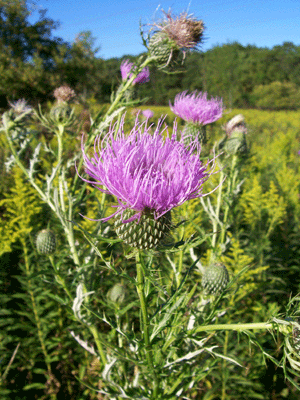Contents:
Common Names | Parts Usually Used | Plant(s) & Culture | Where Found | Medicinal Properties | Biochemical Information
Legends, Myths and Stories | Uses | Formulas or Dosages | How Sold | Warning | Bibliography
Scientific Names

- Cnicus benedictus L.
- Composite family
Common Names
- Bitter thistle
- Blessed cardus
- Holy thistle
- Saint Benedict thistle
- Spotted thistle
Parts Usually Used
The plant
Back to Top
Description of Plant(s) and Culture
Blessed thistle is a hairy annual herb; 10-30 inches tall. Both leaves and stems are hairy. The stems are 5-sided. The leaves broadest at the base; lacerated, spiny-toothed. The flowers are yellow, with a large leafy bract beneath; April to September. Reddish, spinelike projections surround yellow tufts of flowers.
Back to Top
Where Found
Roadsides, waste places. United States; common in California.
Back to Top
Medicinal Properties
Diaphoretic, emetic, tonic, stimulant, fegrifuge
Back to Top
Biochemical Information
Cincin and volatile oils
Back to Top
Legends, Myths and Stories
Blessed thistle has been used medicinally for centuries.
Once considered a rank weed and an obscure food plant (young leaves with spines removed are edible), in recent years this thistle has gained prominence as a medicinal plant, especially in Europe. Clinical trials have found it useful in the treatment of Amanita mushroom poisoning; it is credited with saving a number of lives in Europe.
For menstrual problems, it is taken in combination with other herbs such as ginger, cramp bark, and blue cohosh root. This herb is often included in commercial herbal preparations designed specifically for women.
Blessed thistle is sometimes cultivated, but mostly it has escaped from garden areas.
Back to Top
Uses
One of the oldest folk remedies for the treatment of amenorrhea (absence of the menstrual cycle after the onset of menstruation).
Increases appetite, and stomach secretions. Heals the liver. Improves poor circulation, purifies the blood, increases bile production, helps sluggish appetite, stimulates memory, resolves blood clots, strengthens the heart, and alleviates pneumonitis (inflammation of the lung tissue). Aids milk flow in the nursing mother. Use for colds, fever, headaches, the tea helps digestive problems, as well as gas in the intestines, constipation, and liver troubles, dropsy. Care should be taken not to make the tea too strong as it may cause vomiting. Tea also used for boils, chilblains, deafness, gout, migraines, suppressed menses, jaundice, and ringworm.
Back to Top
Formulas or Dosages
Infusion: 1 oz. dried herb to 1 pint of boiling water.
Back to Top
How Sold
Capsules: take 1 capsule up to 3 times daily
Extract: mix 10-20 drops in liquid daily.
Back to Top
Warning
Handle carefully to avoid toxic skin effects.
Large doses may cause irritation, vomiting.
Should not be taken during pregnancy; it stimulates onset of menses.
Back to Top
Bibliography
![]() Back to Eden
Back to Eden, by Jethro Kloss; Back to Eden Publishing Co., Loma Linda, CA 92354, Original copyright 1939, revised edition 1994
![]() The Herbalist Almanac
The Herbalist Almanac, by Clarence Meyer, Meyerbooks, publisher, PO Box 427, Glenwood, Illinois 60425, copyright 1988, fifth printing, 1994
![]() Eastern/Central Medicinal Plants
Eastern/Central Medicinal Plants, by Steven Foster and James A. Duke., Houghton Mifflin Company, 215 Park Avenue South, New York, NY 10000
![]() Planetary Herbology
Planetary Herbology, by Michael Tierra, C.A., N.D., O.M.D., Lotus Press, PO Box 325, Twin Lakes. WI 53181., Copyright 1988, published 1992
![]() The Complete Medicinal Herbal
The Complete Medicinal Herbal, by Penelope Ody, Dorling Kindersley, Inc, 232 Madison Avenue, New York, NY 10016, First American Edition, copyright 1993
![]() American Folk Medicine
American Folk Medicine, by Clarence Meyer, Meyerbooks, publisher, PO Box 427, Glenwood, Illinois 60425, 1973
 How Indians Use Wild Plants for Food, Medicine & Crafts
How Indians Use Wild Plants for Food, Medicine & Crafts, by Frances Densmore, Dover Publications, Inc., 180 Varick Street, New York, NY 10014, first printed by the United States Government Printing Office, Washington, in 1928, this Dover edition 1974
 Earl Mindell’s Herb Bible
Earl Mindell’s Herb Bible, by Earl Mindell, R.Ph., Ph.D., Simon & Schuster/Fireside, Rockefeller Center 1230 Avenue of the Americas, New York, New York 10020
 Old Ways Rediscovered
Old Ways Rediscovered, by Clarence Meyer, Meyerbooks, publisher, PO Box 427, Glenwood, Illinois 60425, published from 1954, print 1988
![]() Prescription for Nutritional Healing, Fifth Edition: A Practical A-to-Z Reference to Drug-Free Remedies Using Vitamins, Minerals, Herbs & Food Supplements
Prescription for Nutritional Healing, Fifth Edition: A Practical A-to-Z Reference to Drug-Free Remedies Using Vitamins, Minerals, Herbs & Food Supplements, by James F. Balch, M.D. and Phyllis A. Balch, C.N.C., Avery Publishing Group, Inc., Garden City Park, NY
![]() The Yoga of Herbs: An Ayurvedic Guide to Herbal Medicine
The Yoga of Herbs: An Ayurvedic Guide to Herbal Medicine, by Dr. David Frawley & Dr. Vasant Lad, Lotus Press, Twin Lakes, Wisconsin, Second edition, 1988.
![]() Webster’s New World Dictionary
Webster’s New World Dictionary, Third College Edition, Victoria Neufeldt, Editor in Chief, New World Dictionaries: A Division of Simon & Schuster, Inc., 15 Columbus Circle, New York, NY 10023
 The Rodale Herb Book: How to Use, Grow, and Buy Nature’s Miracle Plants (An Organic gardening and farming book)
The Rodale Herb Book: How to Use, Grow, and Buy Nature’s Miracle Plants (An Organic gardening and farming book), edited by William H. Hylton, Rodale Press, Inc. Emmaus, PA, 18049., 1974
